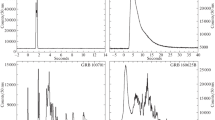Abstract
RECENT measurements by the Burst and Transient Source Experiment (BATSE) on the Compton Gamma Ray Observatory Satellite suggest that the distribution of γ-ray burst sources is isotropic about the Earth's position but also radially non-uniform1. Studies of their spectral and temporal properties2, however, suggest that many bursts originate on or near neutron stars, presumed to be part of the local galactic population. We show here that no single class of bursts, either galactic or cosmological in origin, can explain all of these observations, but argue instead that the constraints can be reconciled if there are at least two distinct classes of bursts. As a specific example we consider two kinds of burst which both originate on galactic neutron stars, but which differ in intrinsic luminosity by a factor of 105.
Similar content being viewed by others
References
Meegan, C. et al. Nature 355, 143–145 (1991).
Higdon, J. C. & Lingengelter, R. E. A. Rev. Astr. Astrophys., 28, 401–436 (1990).
Murakami, T. et al. Nature 350, 592–594 (1991).
Lamb, D., Wang, J. C. L. & Wasserman, I. M. Astrophys. J. 363, 670–693 (1990).
Higdon, J. C. & Lingenfelter, R. E. Astrophys. J. 307, 197–204 (1986).
Schmidt, M., Higdon, J. C. & Hueter, G. Astrophys. J. 329, L85–87 (1988).
Hartmann, D., Epstein, R. I. & Woosley, S. E. Astrophys. J. 348, 625–633 (1990).
Paczynski, B. Astrophys. J. 348, 485–494 (1990).
Paczynski, B. Acta astr. 41, 157–166 (1991).
Paczynski, B. in Huntsville Workshop on Gamma Ray Bursts (eds Paciesas, W.&Fishman, G.) (American Institute of Physics, New York, in the press).
Matz, S. et al. in Gamma Ray Bursts (eds Ho, C., Fenimore, E. E.&Epstein, R. I.) (Cambridge University Press, in the press).
Higdon, J. C. & Lingenfelter, R. E. in High Energy Transients in Astrophysics (ed. Woosley, S. E.) 568–577 (American Institute of Physics, New York, 1984).
Mao, S. & Paczynski, B. Astrophys. J. (submitted).
Mazets, E. et al. Astrophys. Space Sci. 80, 1–143 (1982).
Higdon, J. C. & Schmidt, M. Astrophys. J. 355, 13–17 (1990).
Hartmann, D. et al. in Gamma Ray Bursts (eds Ho, C., Fenimore, E. E. & Epstein, R. I.) (Cambridge University Press, in the press).
Atteia, J. L. et al. Nature 351, 296–298 (1991).
Ogasaka, Y., Murakami, T., Nishimura, J., Yoshida, A. & Fenimore, E. E. Astrophys. J. (submitted).
Author information
Authors and Affiliations
Rights and permissions
About this article
Cite this article
Lingenfelter, R., Higdon, J. Two-population model for the sources of γ-ray bursts. Nature 356, 132–133 (1992). https://doi.org/10.1038/356132a0
Received:
Accepted:
Issue Date:
DOI: https://doi.org/10.1038/356132a0
- Springer Nature Limited
This article is cited by
-
High velocity neutron stars and ?-ray bursts
Astrophysics and Space Science (1996)
-
Four years of BATSE gamma-ray burst observations
Astrophysics and Space Science (1995)
-
Analysis of the log N-log P of the BATSE gamma-ray bursts
Astrophysics and Space Science (1995)
-
Gamma-ray bursts from nearby neutron stars
Astrophysics and Space Science (1993)
-
Threshold effects onV/V max for gamma-ray bursts
Astrophysics and Space Science (1993)





